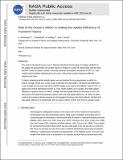Role of the ocean's AMOC in setting the uptake efficiency of transient tracers
Author(s)
Romanou, A.; Marshall, J.; Kelley, M.; Scott, Jeremy
Downloadnihms952768.pdf (1.433Mb)
OPEN_ACCESS_POLICY
Open Access Policy
Creative Commons Attribution-Noncommercial-Share Alike
Terms of use
Metadata
Show full item recordAbstract
The central role played by the ocean's Atlantic Meridional Overturning Circulation (AMOC) in the uptake and sequestration of transient tracers is studied in a series of experiments with the Goddard Institute for Space Studies and Massachusetts Institute of Technology ocean circulation models. Forced by observed atmospheric time series of CFC‐11, both models exhibit realistic distributions in the ocean, with similar surface biases but different response over time. To better understand what controls uptake, we ran idealized forcing experiments in which the AMOC strength varied over a wide range, bracketing the observations. We found that differences in the strength and vertical scale of the AMOC largely accounted for the different rates of CFC‐11 uptake and vertical distribution thereof. A two‐box model enables us to quantify and relate uptake efficiency of passive tracers to AMOC strength and how uptake efficiency decreases in time. We also discuss the relationship between passive tracer and heat uptake efficiency, of which the latter controls the transient climate response to anthropogenic forcing in the North Atlantic. We find that heat uptake efficiency is substantially less (by about a factor of 5) than that for a passive tracer.
Date issued
2017-05Department
Massachusetts Institute of Technology. Department of Earth, Atmospheric, and Planetary SciencesJournal
Geophysical Research Letters
Publisher
American Geophysical Union (AGU)
Citation
Romanou, A., et al. “Role of the Ocean’s AMOC in Setting the Uptake Efficiency of Transient Tracers.” Geophysical Research Letters, vol. 44, no. 11, June 2017, pp. 5590–98.
Version: Author's final manuscript
ISSN
0094-8276